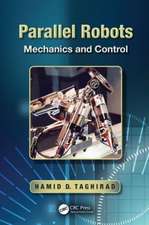Trajectory Planning for Automatic Machines and Robots
Autor Luigi Biagiotti, Claudio Melchiorrien Limba Engleză Hardback – 3 noi 2008
| Toate formatele și edițiile | Preț | Express |
|---|---|---|
| Paperback (1) | 1337.01 lei 6-8 săpt. | |
| Springer Berlin, Heidelberg – 19 oct 2010 | 1337.01 lei 6-8 săpt. | |
| Hardback (1) | 1339.71 lei 6-8 săpt. | |
| Springer Berlin, Heidelberg – 3 noi 2008 | 1339.71 lei 6-8 săpt. |
Preț: 1339.71 lei
Preț vechi: 1633.80 lei
-18%
Puncte Express: 2010
Preț estimativ în valută:
237.10€ • 277.10$ • 205.85£
237.10€ • 277.10$ • 205.85£
Carte tipărită la comandă
Livrare economică 19 februarie-05 martie
Preluare comenzi: 021 569.72.76
Specificații
ISBN-13: 9783540856283
ISBN-10: 3540856285
Pagini: 532
Ilustrații: XIV, 514 p. 326 illus.
Dimensiuni: 155 x 235 x 38 mm
Greutate: 0.82 kg
Ediția:2008
Editura: Springer Berlin, Heidelberg
Colecția Springer
Locul publicării:Berlin, Heidelberg, Germany
ISBN-10: 3540856285
Pagini: 532
Ilustrații: XIV, 514 p. 326 illus.
Dimensiuni: 155 x 235 x 38 mm
Greutate: 0.82 kg
Ediția:2008
Editura: Springer Berlin, Heidelberg
Colecția Springer
Locul publicării:Berlin, Heidelberg, Germany
Public țintă
ResearchDescriere
This book deals with the problems related to planning motion laws and t- jectories for the actuation system of automatic machines, in particular for those based on electric drives, and robots. The problem of planning suitable trajectories is relevant not only for the proper use of these machines, in order to avoid undesired e?ects such as vibrations or even damages on the mech- ical structure, but also in some phases of their design and in the choice and sizing of the actuators. This is particularly true now that the concept of “el- tronic cams” has replaced, in the design of automatic machines, the classical approach based on “mechanical cams”. The choice of a particular trajectory has direct and relevant implications on several aspects of the design and use of an automatic machine, like the dimensioning of the actuators and of the reduction gears, the vibrations and e?orts generated on the machine and on the load, the tracking errors during the motion execution. For these reasons, in order to understand and appreciate the peculiarities of the di?erent techniques available for trajectory planning, besides the ma- ematical aspects of their implementation also a detailed analysis in the time and frequency domains, a comparison of their main properties under di?erent points of view, and general considerations related to their practical use are reported.
Cuprins
Basic Motion Profiles.- Analytic Expressions of Elementary Trajectories.- Composition of Elementary Trajectories.- Multipoint Trajectories.- Elaboration and Analysis of Trajectories.- Operations on Trajectories.- Trajectories and Actuators.- Dynamic Analysis of Trajectories.- Trajectories in the Operational Space.- Multidimensional Trajectories and Geometric Path Planning.- From Geometric Paths to Trajectories.- Appendices.- A Numerical Issues.- B B-spline, Nurbs and Bézier curves.- C Representation of the Orientation.- D Spectral Analysis and Fourier Transform.- Trajectory Planning.- Trajectory Planning.
Recenzii
From the reviews:
“This book is intended for engineers and technicians in the fields of automatic machines and robotics as well as for developers of applications for multiaxis machines and robot cells.” (IEEE Control Systems Magazine, Vol. 30, February, 2010)
“This book is intended for engineers and technicians in the fields of automatic machines and robotics as well as for developers of applications for multiaxis machines and robot cells.” (IEEE Control Systems Magazine, Vol. 30, February, 2010)
Textul de pe ultima copertă
This book deals with the problems related to planning motion laws and trajectories for the actuation system of automatic machines, in particular for those based on electric drives, and robots. The problem of planning suitable trajectories is relevant not only for the proper use of these machines, in order to avoid undesired effects such as vibrations or even damages on the mechanical structure, but also in some phases of their design and in the choice and sizing of the actuators. This is particularly true now that the concept of “electronic cams” has replaced, in the design of automatic machines, the classical approach based on “mechanical cams”.
The choice of a particular trajectory has direct and relevant implications on several aspects of the design and use of an automatic machine, like the dimensioning of the actuators and of the reduction gears, the vibrations and efforts generated on the machine and on the load, the tracking errors during the motion execution. For these reasons, in order to understand and appreciate the peculiarities of the different techniques available for trajectory planning, besides the mathematical aspects of their implementation also a detailed analysis in the time and frequency domains, a comparison of their main properties under different points of view, and general considerations related to their practical use are reported.
The choice of a particular trajectory has direct and relevant implications on several aspects of the design and use of an automatic machine, like the dimensioning of the actuators and of the reduction gears, the vibrations and efforts generated on the machine and on the load, the tracking errors during the motion execution. For these reasons, in order to understand and appreciate the peculiarities of the different techniques available for trajectory planning, besides the mathematical aspects of their implementation also a detailed analysis in the time and frequency domains, a comparison of their main properties under different points of view, and general considerations related to their practical use are reported.
Caracteristici
complete presentation of trajectory planning and motion law generation for automatic machines and robots
suitable for university classes on robotics and on control systems technologies as well as engineers in robotics and automation
accompanied by a Matlab toolbox, for quickly understanding the problems of planning and starting work with trajectories.
Includes supplementary material: sn.pub/extras
suitable for university classes on robotics and on control systems technologies as well as engineers in robotics and automation
accompanied by a Matlab toolbox, for quickly understanding the problems of planning and starting work with trajectories.
Includes supplementary material: sn.pub/extras













